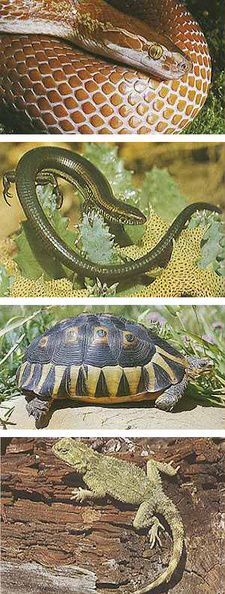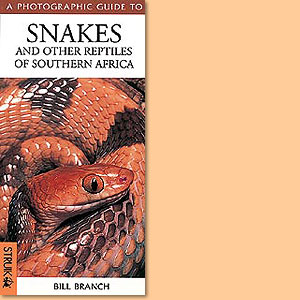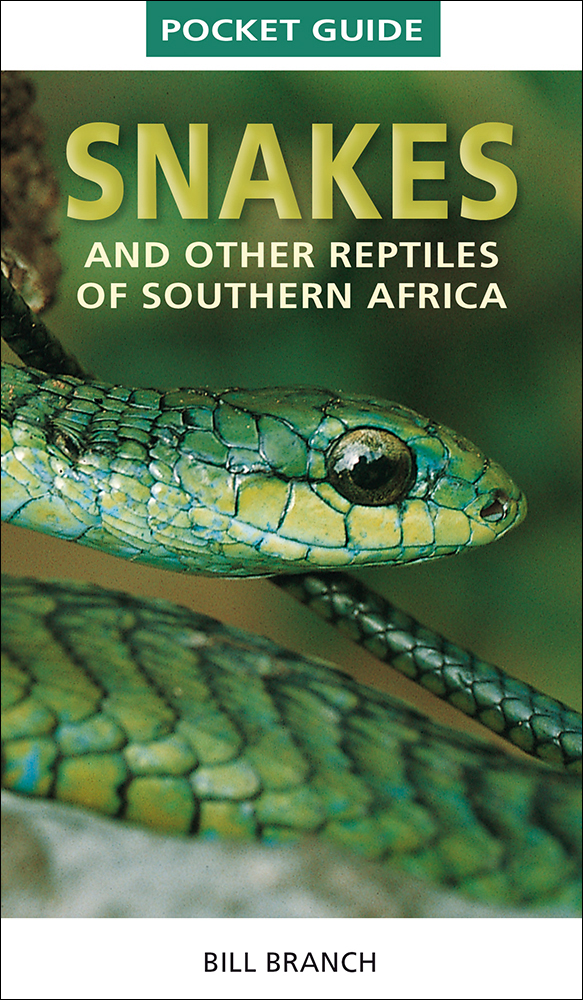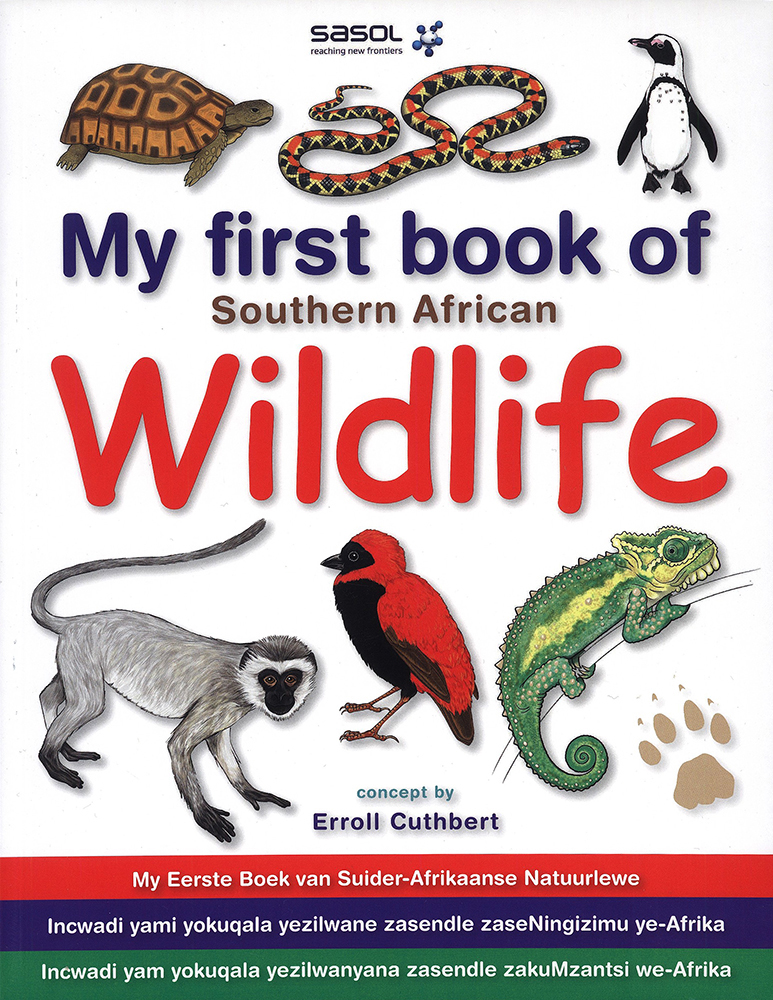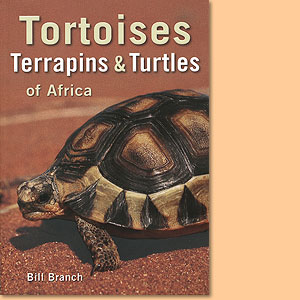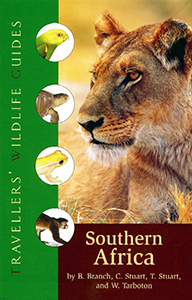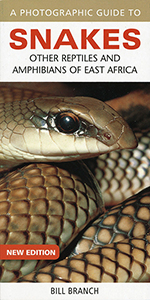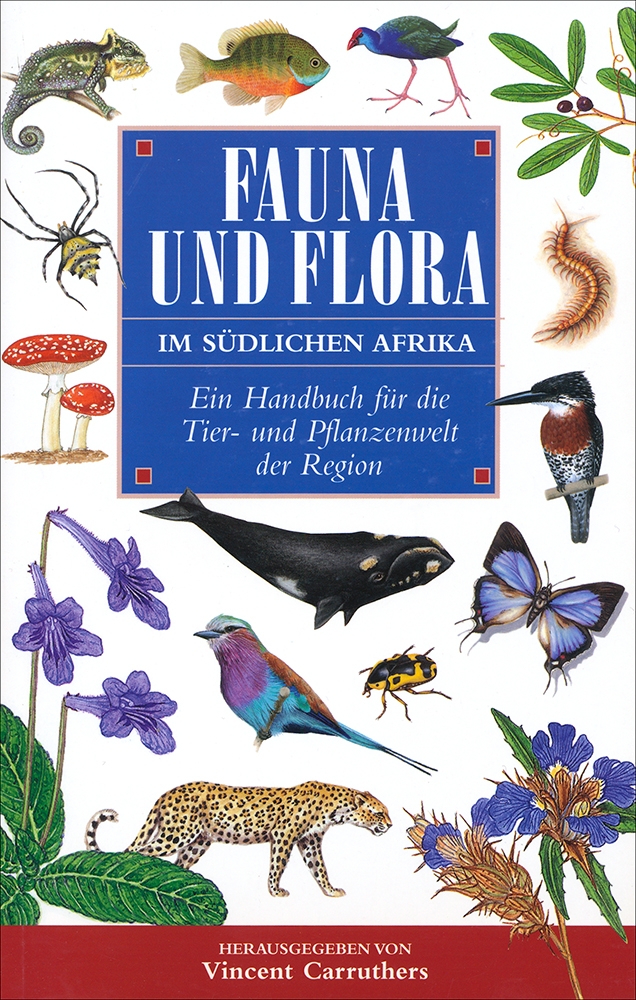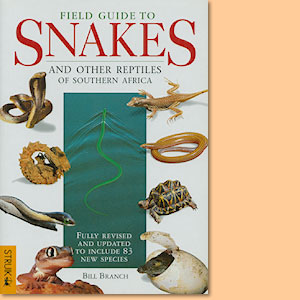A photographic guide to snakes and other reptiles of Southern Africa, by Bill Branch.
With increasing public concern for the environment of Southern Africa, interest in less fashionable wildlife such as reptiles and snakes has grown. This is an introduction by Bill Branch.
If we are to return to harmony with our world, and to integrate with the biosphere rather than continually exploit it, then we need a deeper understanding of life around us. This book is designed to introduce our reptiles, from the feared snakes and crocodile, to the ever-popular tortoises and the secretive and neglected lizards. Southern Africa, that region south of the Zambezi and Cunene rivers, has a tremendous variety of habitats. These harbour a very diverse reptile fauna of nearly 500 species. More than half of these are endemic to the region, that is, found nowhere else. Unfortunately, not all of these can be included in this book.
Those chosen emphasize the more colourful and conspicuous species and those unique to or endangered in southern Africa. However, a number of rare and localized species have also been included to reflect the great diversity which the region supports. Most people realize that not all snakes are poisonous, but many still kill them anyway. The lazy argument is that "it is better to be safe than sorry". However, of 146 snake species found in southern Africa, less than one quarter are dangerous. Of these, 14 have caused death and a further 18 have venoms whose symptoms may range from inconvenient to serious. Many regions have less than a handful of dangerous species, and it requires little effort to recognize these. All are included in this guide. Living reptiles are an extremely diverse class, and the relation-ships between the main orders and families are still controversial. Four main lineages survive. The lizard-like tuataras (Order Rhyn-chocephalia) are restricted to New Zealand. The remaining three orders all occur in southern Africa, including the crocodilians (Order Crocodylia), tortoises, terrapins and turtles (collectively called chelonians, Order Chelonia), and snakes, lizards and worm lizards (collectively called squamates. Order Squamata). Crocodiles are more closely related to dinosaurs and birds than to other reptiles. Squamates (scaled reptiles) are all closely related, with snakes and amphisbaenians (worm lizards) evolving from lizards approximately 80 million years ago.
Unlike birds, which are often common and highly visible, most reptiles are small, secretive and shy. To find or observe them usually requires patience and careful searching. Reptiles have only limited mobility and many have very specific habitat requirements. In general, lizards can be considered habitat-linked and snakes food-linked. This is reflected in many of their common names. Thus, among snakes we talk of egg eaters, centipede eaters and slug eaters, and among lizards of desert lizards, rock lizards and the water monitor. In practical terms this means that lizards often have very small ranges within which they inhabit specific places. Snakes often range over large areas and occur in different habitats, but search for specific prey.
In the southern, more temperate regions, mating occurs in spring as daytime temperatures rise, whilst in the north mating often occurs at the start of the wet season. Male snakes become more active at these times, searching for receptive females. Dominant males among the colonial agamas and skinks develop bright breeding colours, and lead active lives defending their territories and chasing mates. The majority of reptiles, including all crocodiles and chelonians, are oviparous (egg-laying). Most lay clutches of between five and 20 eggs, although large sea turtles may lay up to 1000 in a season; most geckos lay only two eggs at a time. With two exceptions, parental care in all local reptiles ends when the eggs are laid and the nest hole covered.
The Southern African Python and Nile Crocodile both brood their eggs until they hatch. In crocodiles and sea turtles the sex of the embryo is dependent upon the temperature at which the egg is incubated. In crocodiles, males develop in eggs at high temperatures, while the same temperatures in turtles produce females. Many squamates are viviparous, retaining their eggs within the body and giving birth to live young. This is usually associated with life in cool climates.
Bill Branches advice how to use the photographic guide to snakes and other reptiles of Southern Africa:
Clarity and ease of use have been the main criteria of Bill Branch in the design of this guide. In the succinct species descriptions, key features for identification are emphasized in italic type. In some difficult groups, such as thread snakes and sand lizards, it may be necessary to have the specimen in hand to obtain detailed scale counts before a positive identification can be assured. As with birds, field identification is not always easy and depends on sensible and good observation. When first spotting a reptile, try to note the following features. What was the general build? Was the coloration uniform or patterned, and, if the latter, was it plain striped, blotched, etc? Was the tail longer or shorter than the body?
Were the body scales large or small, smooth or rough, arranged in rows or scattered? What habitat was it in, and what was it doing? These features should be jotted in a field book, as an aid for comparison with the pictures in the species accounts. The thumbnail silhouettes allow quick access to the reptile group most closely resembling the species you have seen. Further field hints are given below. A glossary of specialized terms and diagrams showing the anatomy of various reptiles are featured on pages 139-140.
When you find an illustration that is similar to your unknown species, check whether it occurs in the region. If there is a big difference between where you have found it and where it should be, try another picture. Although many reptile distributions are poorly known, you are unlikely to discover major range extensions. It is more likely that you have simply misidentified it. Remember that many reptile species, particularly lizards, are not included in this guide. You are directed to a selection of further reading (page 140) that should facilitate identification of any unusual species.
Example: Common Purple-glossed Snake
Amblyodipsas polylepis
40-60 cm
When the skin is freshly shed, the smooth scales of this black snake have an attractive purple gloss. Unlike the Natal Black Snake (page 39), with which it is easily confused, it has 15-31 paired subcaudals. It is a stocky snake, with a blunt head and small eyes.
Tere are 19-21 midbody scale rows, and usually only 6 upper labials. It is found in the moister regions of the north-eastern savannas, and feeds mainly on burrowing reptiles, particularly blind snakes. Small prey is swallowed alive, whilst larger prey is constricted. Breeding unknown. It is a gentle snake and rarely bites.
This is an extract from the book: A Photographic Guide to Snakes and other Reptiles of Southern Africa, by Bill Branch.
Book title: A Photographic Guide to Snakes and other Reptiles of Southern Africa
Author: Bill Branch
Struik Publishers
Cape Town, South Africa 2001
ISBN-10: 1868726193
ISBN-13: 978-1-86872-619-6
Softcover, 10x19 cm, 144 pages, many colour photos
Branch, Bill im Namibiana-Buchangebot
A photographic guide to snakes and other reptiles of Southern Africa
Althoug a handy and basic guide, this photographic guide to snakes and other reptiles of Southern Africa shows excellent photographs.
Snakes and other Reptiles of Southern Africa (Pocket Guide)
This pocket guide features 276 species of snakes and other reptiles of Southern Africa.
My first book of Southern African wildlife
My first book of Southern African wildlife introduces children to 58 mammals, 58 birds and 56 reptiles.
My first book of Southern African snakes and other reptiles
My first book of Southern African snakes and other reptiles introduces 56 different species in English, Afrikaans, Zulu and Xhosa and is made for young readers.
Tortoises, terrapins and turtles of Africa
Good colour photographs for easy identification of 46 chelonian species of Africa, tortoises, terrapins and turtles.
Traveller's Wildlife Guide Southern Africa
Traveller's Wildlife Guide Southern Africa introduces 500 of Southern Africa’s most common amphibians, reptiles, birds, and mammals.
A photographic guide to snakes, other reptiles and amphibians of East Africa
This is a handy and well made photographic guide to most of the common snakes, reptiles and amphibians of East Africa.
Fauna und Flora im südlichen Afrika
Fauna und Flora im südlichen Afrika: Ein sehr beliebtes Handbuch für die Tier- und Pflanzenwelt der Region.
Field guide to snakes and other reptiles of Southern Afrika
Fully revised and updated, this field guide to snakes and other reptiles of Southern Afrika includes 83 new species.

